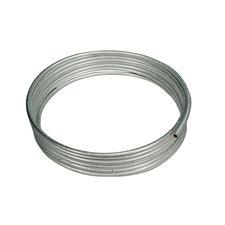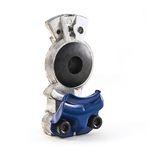Everyone knows that brakes cause a vehicle to stop, but may not exactly know how brakes work. There is more then one type of brake, so to clear up any confusion we sat down with Del City’s Technical Expert. In this segment, our Technical Expert will answer common questions about air brakes and hydraulic brakes, as well as how they differ from electric brakes. Hopefully our Technical Specialist is able to clear up this topic and increase your industry knowledge of these systems.
Q: Where in the industry do air brakes shine?
A: Air brakes are great for semi-trucks and large trailers. In comparison to hydraulic or electric brakes, air braking systems are better for heavier applications. Electric brakes are more commonly used in small trailers where air braking would be overkill.
Q: Are Hydraulic and Electric brakes the same thing?
A: No! Hydraulic brakes are fluid based. When the hydraulic brake is triggered, the cylinder pushes fluid to the brake pads. This fluid then pushes through the rotor between the pads to stop the vehicle. Electric braking is done through magnets and a completely electrical design. Air braking is a similar concept to hydraulic breaking, whereas electric brakes are a completely different design.
Q: What are some pros and cons of air braking systems?
A: A pro is it can handle heavier applications where an electric braking system won’t do the trick. Often an air braking system is the only option to get a heavy truck/semi to stop properly. It can also be argued that in the long run, air braking systems are easier to maintain. A con is that air brakes are often more costly because they require more parts. The tow vehicle would need to be fitted for air brakes, as well as needing a compressor and air tank.
Q: Let’s get into the physical parts of a hydraulic brake system. Can you give a brief description?

Hydraulic Brakes
A: 1. Hydraulic steel brake line tubing (see photo to the right) is your main brake line. You can cut it to the length you want and add your own fittings.
2. PVF brake lines are the steel lines described above with a coating for corrosion resistance. This is great for dealing with harsher environments or issues such as road salt or standing water. For example, these brake lines work great for winter climates where snow and ice is an issue
3. Hydraulic steel brake lines are the same as the tubing described above, but set to specific sizes. They come with fittings attached. These are best for smaller applications where you don’t need custom sizing.
4. Brake line fittings connect the brake lines to either the hoses are actual brake line components such as cylinders. These are necessary for a complete brake assembly. Fittings also include adapters to make sure you have a custom fit.
Q: Air brakes are similar in design to hydraulic brakes, but have different parts. Can you describe them?
A: 1. Nylon tubing is your main line. The air flows through this tubing to stop the vehicle. The nylon is more flexible than the stainless steel tubing used in hydraulic brakes

Air Brakes
2. Rubber hose assemblies are your connection from the main lines described above to the brakes themselves. These allow flexibility when the wheels are moving.
3. Gladhands (see photo to the right) are your connection between the vehicle and the trailer. They allow easy coupling as well as added protection
4. Coiled air assemblies are the lead lines coming off the gladhands for the trailer, usually found on the trailer side. They give you flexibility and the ability to adjust when towing a vehicle. The coil extends farther to adjust for the distance between the trailer and truck, making the movements easier
5. 3-in-1 wraps are a convenient product that has everything in one. It has one main assembly for the air brake lines and trailer cable, making a tow easier. It also provides a cleaner look, as you won’t have 3 different parts in your application.
Q: Any final tips for someone using air braking of hydraulic braking systems?
A: Be sure to continually check for leaks to be sure your brakes are running properly. In a hydraulic system, you will see the fluid leaking. An air braking system is different and you will be able to hear if air is leaking from your tubing.
Thanks to Del City’s Technical Specialist for sitting down with us to answer some questions! If you have recommendations for upcoming topics on “Ask the Expert” feel free to email us at social@delcity.net. With any more questions, don’t hesitate to reach out to our team at 1.800.654.4757.
Want more content? We frequently update our blog, “The Current,” with new material. Check it out here!
